Description and photos of the best varieties of cauliflower
Thanks to the work of breeders, there are many varieties and hybrids of cauliflower. Before choosing a crop, it is important to determine the goals of planting: to get an early harvest or excellent taste, to plant one that is cold-resistant or that is richest in vitamins and microelements.
What does cauliflower look like?
Cauliflower is an annual plant second only to white cabbage in popularity. This tasty and healthy vegetable is a dietary and hypoallergenic product.
An unusual culture was brought to us from Western Europe a little over 200 years ago. It is more capricious and demanding of growing conditions compared to cabbage.
Cauliflower is called so because of the head, which is a large inflorescence of fused fleshy peduncles pressed against each other.
Reference. Important have time to cut the head of cabbage, until the flower stalks begin to bloom, otherwise it will become inedible.
The bush is powerful and spreading. On a cylindrical stem 15 to 70 cm high, a rosette of 20–30 large leaves is first formed, then a head of cabbage begins to form. The color of the leaves varies from light green to bluish.
The fork is round, cone-shaped or flattened. Usually white in color, but there are plants with yellow, cream, purple and greenish inflorescences.
Cauliflower is otherwise called Syrian, and popularly called curly and curd.
The photo shows cauliflower.
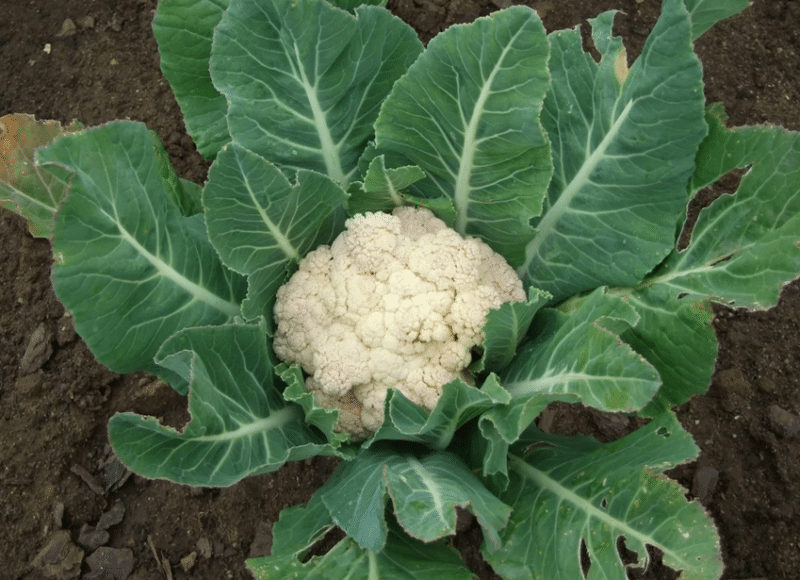
Types, best varieties and hybrids of cauliflower for open ground
Cauliflower varieties differ in ripening time, shape, size and taste.
Early
Early plants ripen faster than others: 80–100 days from emergence. They are well suited for more northern regions with short summers.
Snowball 123
The variety, originally from France, quickly gained popularity in Western Europe, and in 1994, Russian vegetable growers became acquainted with it. Unpretentious culture suitable for growing in different regions of the country.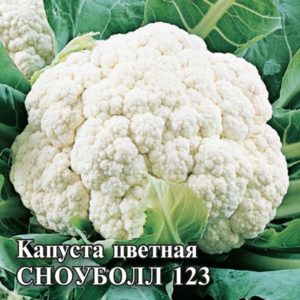
The heads of cabbage are not large in size. The size of the dense, round, sometimes slightly flattened heads is average: in the range of 0.5–1.2 kg, depending on compliance with agricultural practices, the climate of the region and weather conditions in the current season.
The heads are lumpy and snow-white. Hence the name of the variety - Snowball, which means “snowball”. The leaves are large, bluish-green, raised high and almost completely cover the head of cabbage from bright sunlight, so it remains snow-white until fully ripe.
The crop shows good productivity: from 1 m², with proper care, it is possible to harvest up to 2.5 kg of vegetables. Advantages of the variety:
- resistance to temperature changes (withstands up to -3...-4°C);
- good immunity to clubroot, blackleg, downy mildew;
- friendly ripening of heads of cabbage;
- universal purpose: cabbage is baked, fried, pickled, added to first courses.
Due to its delicate structure and rich vitamin composition, Snowball is recommended for baby food.
Unibotra
Unibotra is the result of the work of German breeders. Adapted for both indoor and open ground. Direct sowing into soil is possible. Cabbage is grown in a heated greenhouse throughout the year.In this case, the variety produces the highest yields with regular watering and on loose, fertile soils.
The bush is vigorous, spreading, and sits firmly due to its well-developed root system. It is formed by large, wide leaves of a bluish color that protect the heads from sunburn, yellowing and pests.
The heads of cabbage are dense, with a fine-grained surface, compact, dome-shaped and snow-white in color. Weight - from 2 to 2.5 kg. Unibotra cabbage yields 5-6 kg of yield per 1 m².
Advantages:
- resistance to hot weather;
- maintaining color and freshness long-term storage;
- crack resistance;
- the possibility of long-term transportation without loss of commercial qualities;
- versatility in cooking.
The only drawback is the requirement for planting in a sunny and fertile area.
Movir 74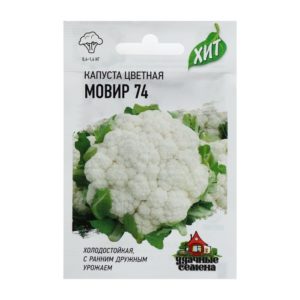
Cauliflower Movir 74 was bred by Russian breeders. It is perfectly adapted to various climatic conditions.
Compact, rounded leaves form a rosette with a diameter of about 70 cm. The color is gray-green or pure green.
Attention! Movir 74 can be susceptible to fungal, viral and bacterial diseases.
Heads, depending on the quality of care, can be either medium or large. They have a granular surface and are very dense, which allows for mechanical harvesting. Weight - from 700 g to 1.3 kg. The shape is round, the color is white, sometimes with a slightly yellowish tint. 4-5 kg of vegetables are harvested from 1 m². The inflorescences are very delicate in taste and are suitable for consumption both fresh and processed.
Mid-season
Medium-ripening varieties and hybrids require 100–110 days and stable warm weather (above +20°C) to reach removable maturity.Their main advantage over early plants is their longer shelf life.
Summer resident
The Dachnitsa variety is one of the most popular in central Russia. It is grown outdoors and in greenhouses; it tolerates temperature changes well. It has a long fruiting period.
The leaves are medium-sized, green, with a slight waxy coating. Reliably protect the ripening head from scorching sun rays. The heads of cabbage are usually small in size, dense, the surface is fine-grained, the shape is round, slightly flattened. The color is snow-white, sometimes slightly creamy.
Cabbage tolerates transportation well and, if stored properly, does not lose its beneficial properties for a long time. The yield of Summer Residents is 2.5–3 kg/m². Vegetables are suitable for preparing any dishes and canning.
Lecanu F1
Lekanyu cauliflower is popular among farmers and entrepreneurs due to its unpretentiousness, easy care and excellent taste.
This is a Dutch hybrid. The plant is powerful, with a highly developed root system. The leaves are medium in size, gray-green in color, with a waxy coating and wavy edges.
Reference. Lekanyu is resistant to major diseases, drought and sudden changes in weather conditions.
The heads of cabbage are large and very dense (2-3 kg each), dazzling white in color. The taste is excellent. Vegetables tolerate freezing well. Productivity - 3.7 kg/m².
Parisian
Parisianka is a productive hardy variety of Russian origin. Included in the State Register in 2006. Approved for cultivation in all regions of the country.
The leaf rosette of the plant is vertical, the edges of the leaves are wavy. The forks are large, with a dense internal texture, a moderately lumpy surface of a white-cream color. The shape is dome-shaped. Although the heads are partially covered with leaves, they are well protected from cold and heat.Weight - 1.5–2 kg. On average, 2.5 kg of cabbage is harvested from 1 m².
The variety is consistently productive, resistant to heat and cold, does not require special care, but is very moisture-loving and does not tolerate soil with high acidity. The harvest is stored for up to 2 months. The taste of the inflorescences is balanced: slight sweetness with pleasant sourness. They are eaten fresh, canned and frozen.
Late
Late varieties of cauliflower ripen no earlier than 120–130 days after germination. They are distinguished by larger heads of cabbage, long shelf life and preservation of marketability during long-term transportation.
Cortez F1
Among the varieties of late cabbage, this hybrid is considered one of the most productive and beautiful. It is mainly grown for sale. Suitable for all regions of Russia.
The rosette of cabbage is formed by small leaves of light green color that cover the head, which allows it to maintain an attractive appearance. It is rich white in color, very dense, massive and juicy. Weight - from 0.6 to 2 kg.
Reference. The plant loves fertile soil and systematic feeding.
The productivity of the hybrid is high: from 2 to 4 kg of heads of cabbage are collected from 1 m². Since the hybrid is late-ripening, the heads are able to ripen even during the first autumn frosts. The value of Cortez is the stable yield and high quality of vegetables that are suitable for home cooking and freezing.
Incline F1
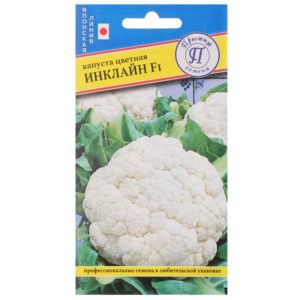
Incline belongs to the category of late-ripening hybrids; it matures 80–90 days after planting the seedlings in the ground.
Cabbage is zoned throughout Russia. Resistant to fungi and pests, tolerates sudden changes in temperature.
The rosette of the plant is raised, formed by large, wavy leaves with a medium waxy coating.The head of cabbage is large, ellipse-shaped, dense and white, average weight is 0.6–1 kg.
The taste is good. Productivity - 2.5 kg/m². Cabbage is suitable for fresh consumption, processing and freezing.
Dutch selection
Dutch cauliflower hybrids are distinguished by their resistance to many diseases, good yield and large head size. However, for stable yields they require moderate temperatures and well-moistened soil. Description of some plants:
- Fremont F1 - a hybrid of medium maturation. It has a powerful rosette of dark green leaves. The shape of the head of cabbage is round, reminiscent of a pear, the surface is lumpy. Average weight is 1.5–2 kg. The plant is resistant to diseases and heat. Productivity depends on growing conditions and is 4.6–5.5 kg/m².
- Kerdes F1 - high-yielding mid-early hybrid. It takes 75 days from planting seedlings to harvesting. Forms large snow-white forks of high quality, weighing up to 2 kg each. The pulp is juicy, dense, excellent taste. Productivity - 2.9 kg/m². Vegetables are suitable for processing and freezing.
- Freedom F1 - a mid-early hybrid with a growing season of 70–75 days from the moment of transplantation. The plugs are uniform, which is good for mass growing. Their weight is 1.8–2.2 kg, the flesh is dense and tender. It is used for cooking, freezing and canning. Freedom is resistant to drought, excessive humidity, and feels comfortable even on poor soils. From 1 m² you get about 3 kg of cabbage.
These hybrids are popular in Russia, adapt well and produce high-quality harvests.
Special varieties
Breeders have created cauliflower not only with excellent taste and strong immunity, but also with different colors of inflorescences. Multi-colored heads of cabbage will decorate the garden until autumn:
- Clara's corals - a mid-late variety, recently bred by Gavrish. Looks very attractive: small heads (250 g) purple color framed by light green leaves. Cabbage is very tasty and beautiful, it is often called an edible flower.
- Green snowdrift - a late-ripening variety included in the State Register in 2015. Cabbage has high resistance to bacteriosis, cold resistance and unpretentiousness. The heads are painted bright green, the leaves of the rosette are grayish. The average weight of the forks is 740–840 g. The taste is excellent. Productivity is low - 2.1 kg/m².
- Yarik F1 - mid-early hybrid, ripens on the 65th day from seed germination. The bush is semi-spreading, forms orange heads, which is why landings look very impressive. Average weight - 300–500 g. The taste of fresh and processed cabbage is excellent. From 1 m² you get up to 2.5 kg.
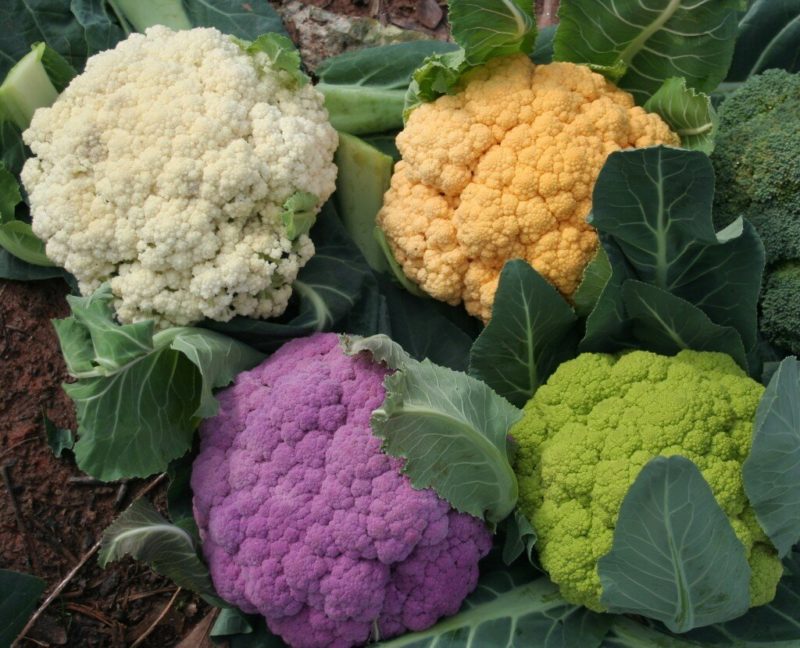
Conclusion
Growing a decent crop of cauliflower is not difficult. It is important to choose the right variety that will correspond to the climatic conditions of the region. Experienced gardeners first of all pay attention to the timing of crop ripening. Thanks to the variety of varieties and a wide selection of seeds, everyone can choose the best option for planting.